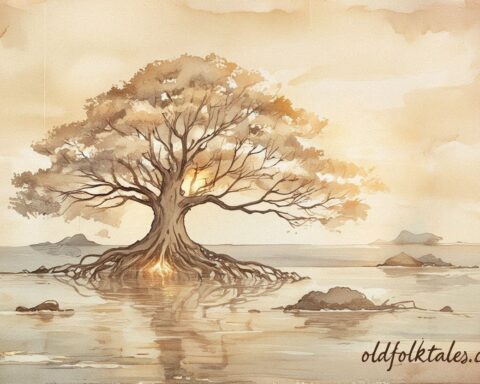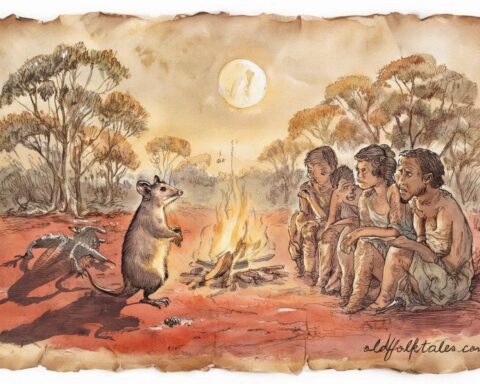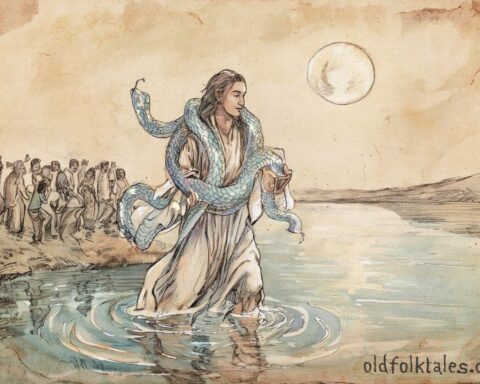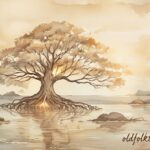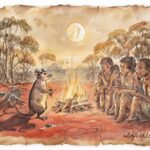In the time before time, when the world lay flat and dry beneath a silent sky, the earth had no rivers, no valleys, and no song of water. The land cracked beneath the sun’s heat, and the first people wandered in search of cool shade and food. Beneath that quiet surface, however, something vast and powerful stirred. Deep within the belly of the earth slept the Rainbow Snake, an ancestral being of light, color, and unending energy.
It had slept since the beginning of creation, coiled in the darkness, dreaming of movement and sound. When its dream reached the surface, the ground trembled, and the people looked to the horizon in fear. The wind changed, carrying a strange, heavy scent of rain and thunder.
One morning, the Rainbow Snake opened its great eyes. Their light shone like twin suns beneath the soil. With a rumble that echoed through mountains and plains, it began to rise. The earth split open as the enormous being uncoiled, and its shimmering scales caught the first rays of light.
As it stretched and moved, the world began to change. Wherever the Rainbow Snake slid, the land sank into deep furrows, forming riverbeds. Its twisting path became winding valleys, and its weight pressed hollows into the ground that filled with water. The people watched in awe as the once-dry world shimmered with life.
The Rainbow Snake drank from these new waters, and the rain followed its breath. Clouds gathered and broke open, filling the rivers and lakes. The trees began to grow, grass covered the plains, and animals returned to the places the Snake had passed. It was said that the Rainbow Snake carried in its body the colors of life itself green for growth, blue for water, yellow for warmth, and red for strength.
As the world awakened, the people rejoiced. They sang songs of gratitude and offered gifts of leaves and flowers at the waterholes where the Snake had rested. These sacred places were known as Dreaming sites, where the power of the Rainbow Snake could still be felt.
But as with all great power, the Rainbow Snake demanded respect. It was both a giver and a destroyer of life. When the people forgot their reverence and polluted the waters or hunted without need, the Snake’s spirit stirred again. Its movement brought storms and floods that swept through the land. Its anger dried up the rivers and cracked the earth.
The elders taught that harmony must always be maintained. The people were to take only what was necessary and to care for the land that sustained them. The Rainbow Snake was not merely a creature but a living law, a reminder that creation and destruction are two halves of the same circle.
In some regions, the Rainbow Snake was called Ngalyod; in others, Wagyl or Almudj. Each name carried its own song and story, passed down from one generation to the next. Children learned that the arching rainbow across the sky was the Snake moving between worlds, watching to see whether humans lived in balance.
One tale tells of a great drought that came when the people quarreled and forgot their ceremonies. The rivers dried up, and animals fled. The elders gathered and sang the old songs, calling upon the Snake for mercy. From the western hills came a rumble, and the Rainbow Snake rose once more. It stretched across the sky, shimmering with rain, and the clouds broke open to water the land. The rivers flowed again, and peace returned.
From that day, every time rain touches the red earth and the rainbow arches high above, the people remember. They say, “The Rainbow Snake moves again. The land is breathing.”
The Rainbow Snake remains one of the most sacred beings of the Dreamtime. It is creation made visible, the pulse of the earth and sky, the voice of thunder, and the arc of color after rain. To honor it is to honor the bond between humankind and nature.
Even now, Aboriginal custodians tend to the sacred waterholes and caves where the Snake once rested. They speak its name with care, for it holds the memory of all beginnings and the promise of renewal.
Moral Lesson
The legend of the Rainbow Snake teaches that creation and destruction are bound together in balance. When humans respect the earth and its living laws, life flourishes. When they forget, the same forces that give life can also take it away.
Knowledge Check
1. Where did the Rainbow Snake first awaken?
It awoke deep within the earth, beneath the dry and silent land.
2. What did the Rainbow Snake create as it moved across the land?
Its movement carved rivers, valleys, and waterholes, bringing life to the world.
3. How did the Rainbow Snake bring rain and renewal?
Its breath drew clouds to the sky, and its presence called the rains that filled the rivers.
4. What happens when people disrespect the natural world?
The Rainbow Snake grows angry, causing floods, storms, or droughts to remind humans of balance.
5. What does the rainbow symbolize in Aboriginal belief?
It represents the Snake moving through the sky, connecting heaven, earth, and the spirit world.
6. What moral teaching does this story convey?
That respect for the land and the forces of nature ensures harmony and life for all beings.
Source: Adapted from “The Rainbow Snake” in Aboriginal Myths: Tales of the Dreamtime by A. W. Reed (1978), Terrey Hills, N.S.W.: Reed.
Cultural Origin: Australian Aboriginal (Dreamtime, widespread across northern and central regions)

